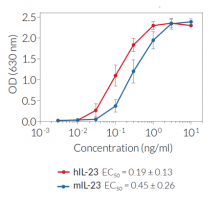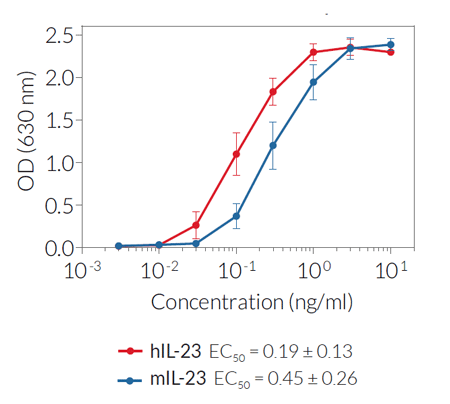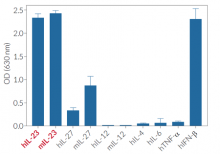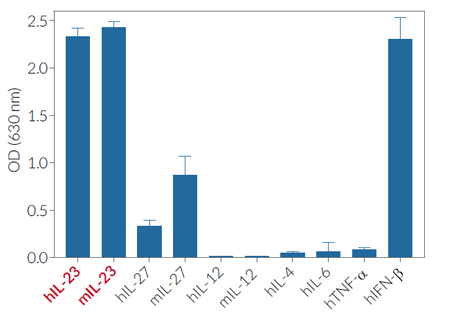IL-23 Reporter HEK 293 Cells
| Product | Unit size | Cat. code | Docs. | Qty. | Price | |
|---|---|---|---|---|---|---|
|
HEK-Blue™ IL-23 Cells Human & Mouse IL-23 Reporter Cells |
Show product |
3-7 x 10e6 cells |
hkb-il23
|
|
IL-23 Reporter Cells
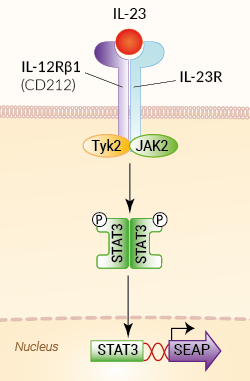
IL-23 signaling pathway
in HEK-Blue™ IL-23 Cells
HEK-Blue™ IL-23 cells allow the detection of bioactive human and mouse interleukin-23 (IL-23). These cells derive from the human embryonic kidney HEK293 cell line. They can be used for the screening of anti-IL-23 antibodies.
IL-23, a member of the IL-12 family, is a key cytokine in the promotion of chronic inflammation [1-3].
Cell line description:
HEK-Blue™ IL-23 cells were generated by stable transfection of HEK293 cells with the human genes for the IL-23 receptor and STAT3 to obtain a fully functional IL-23 signaling pathway. In addition, they express a STAT3-inducible secreted embryonic alkaline phosphatase (SEAP) reporter gene. For your convenience, InvivoGen provides QUANTI‑Blue™ Solution, an easy and rapid means to detect and quantify SEAP.
Features of HEK-Blue™ IL-23 cells:
- Fully functional IL-23 signaling pathway
- Readily assessable SEAP reporter activity
- Functionally tested and guaranteed mycoplasma-free
Applications of HEK-Blue™ IL-23 cells:
- Detection of human and murine IL-23
- Screening of anti-IL-23 antibodies
Specifications
Antibiotic resistance: blasticidin, hygromycin, Zeocin®
Growth medium: DMEM, 4.5 g/l glucose, 2-4 mM L-glutamine, 10% (v/v) fetal bovine serum, 100 U/ml penicillin, 100 μg/ml streptomycin, 100 μg/ml Normocin™
Guaranteed mycoplasma-free
Specificity: human & murine IL-23
Detection range: 100 pg/ml - 10 ng/ml for hIL-23 & mIL-23
These cells are covered by a Limited Use License (See Terms and Conditions).
Back to the topContents
- 1 vial containing 3-7 x 106 cells
- 2 x 1 ml of HEK-Blue Selection (250X concentrate)
- 1 ml of Normocin™ (50 mg/ml)
- 1 ml of QB reagent and 1 ml of QB buffer (sufficient to prepare 100 ml of QUANTI-Blue™ Solution, a SEAP detection reagent).
![]() Shipped on dry ice (Europe, USA, Canada and some areas in Asia)
Shipped on dry ice (Europe, USA, Canada and some areas in Asia)
Details
Interleukin 23 (IL-23), a member of the IL-12 family, is a heterodimeric cytokine composed of the IL-12p40 and IL-23p19 subunits.
IL-23 plays a crucial role in the development and maintenance of T helper 17 cells [1]. It acts by binding to a receptor complex consisting of the IL-12 receptor β1 (IL-12Rβ1) and the IL-23 receptor (IL-23R). Upon binding, IL-23 triggers a signaling pathway involving tyrosine kinase 2 (TyK2) and Janus kinase 2 (JAK2) leading to the activation of signal transducer and activator of transcription 3 (STAT3).
IL-23 has been identified as a central cytokine in autoimmunity and a highly promising treatment target for inflammatory diseases [1-3].
1. Teng MW. et al., 2015. IL-23 and IL-23 cytokines: from discovery to targeted therapies for immune-mediated inflammatory diseases. Nat Med. 21(7):719‑29.
2. Vignali DA. & Kuchroo VK., 2012. IL-12 family cytokines: immunological playmakers. Nat Immunol. 13(8):722-8.
3. Duvallet E. et al., 2011. Interleukin-23: a key cytokine in inflammatory diseases. Ann Med. 43(7):503-11.
Back to the top





